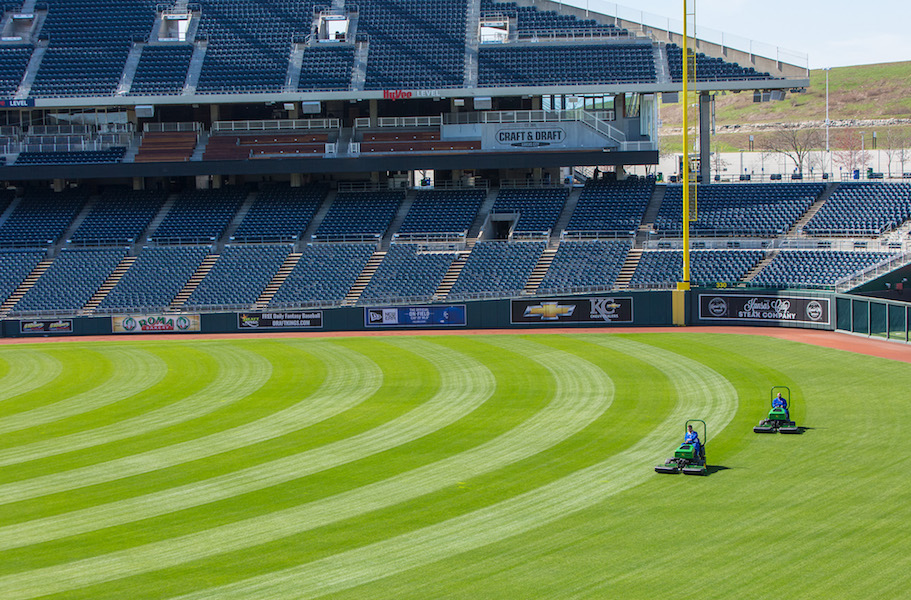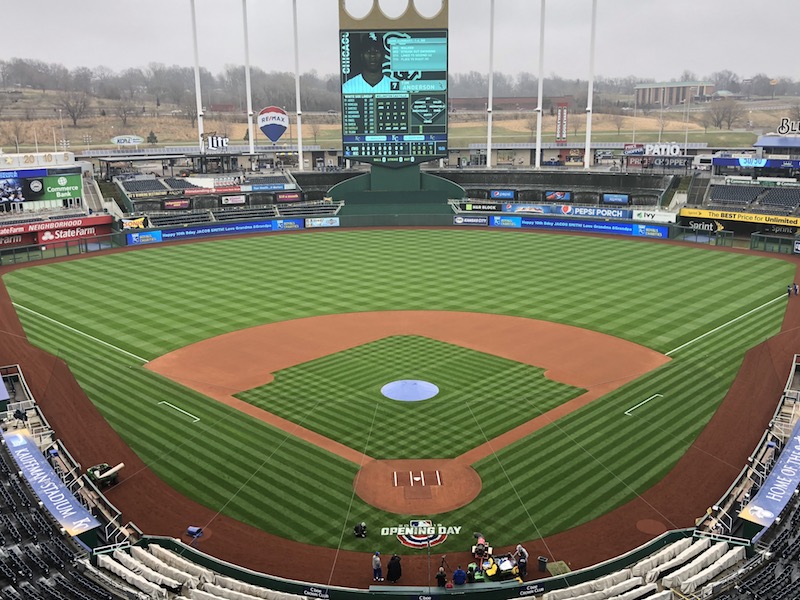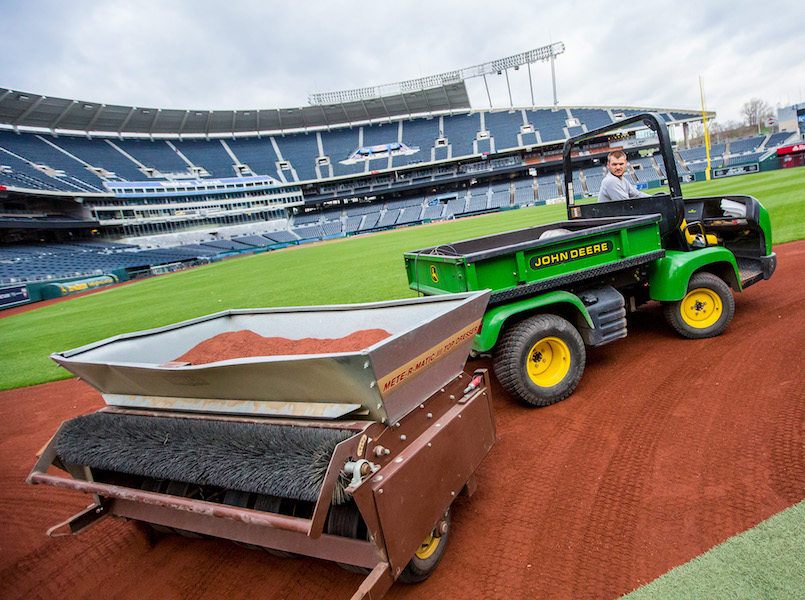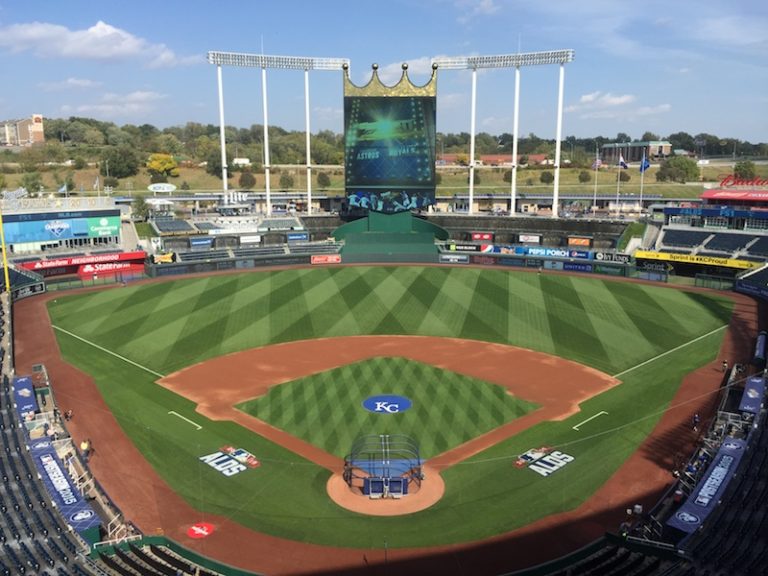By John Kmitta
Trevor Vance, Kansas City Royals senior director of groundskeeping and landscaping, recently shared some advice for dealing with current challenges and presenting safe, visually stunning fields no matter the circumstances.
Adapting to a changing environment
The COVID-19 pandemic forced Vance to downsize his crew, and split what remained into two crews with one working Monday, Wednesday and Friday, and the other working Tuesday, Thursday and Saturday.
“One thing I stress to our front office is that the coronavirus does not affect grass,” said Vance. “It continues to grow, and needs maintenance and needs attention. These fields are thoroughbreds. It’s not a native soil that can rely on Mother Nature. They are a big investment.”
During the past few years, the Royals have invested $2 million in a field rebuild, more than $400,000 in landscaping renovations, and also constructed a new urban youth academy.

“If there is a silver lining, all we do as groundskeepers in March is push our plant and push our plant to get it green and growing for Opening Day,” said Vance.
The lack of field use gave sports field managers the opportunity do the aerification, verticutting and applications that they normally wouldn’t have time for.
“We’ve never been able to come in here April or May and verticut because not only did we have a Major League schedule, but we also have all our extra events – high school games, corporate events, batting practices, and all these other things. The only thing that has been on that field since March 1st is us. So we’ve really been able to do some cultural practices that we are not normally used to.
“Everybody’s field is probably as strong and healthy as it has ever been going into June, which is great,” he added. “If we do resume baseball, now we’re looking at June, July, August – really a three-month window of potential heat – and then you’re back into September. And it didn’t get beat up March, April and May, and then have to get through the season. You are probably going to start the most concerning part of your season through the heat with the strongest grass you’ve ever had.” [Editor’s note: This interview was conducted in early June.]
Vance added that there is some concern with potentially hosting Spring Training at their home site and the impact on the field when play resumes. “But I think we can stay on top of it,” he said, and added that the field should look good on television.
“We are all professionals, and we want this thing to shine. It doesn’t just represent us, it represents the team and the city. Our goal every game is for this to be the best looking turf in Kansas City and the viewing audience.”

Hosting events
When it comes time to actually host other events on the field – from dog days at the park to campouts on the field to corporate events, concerts, fairs and more – Vance’s advice to prepare for – and recover from – those types of events is to “plan for the worst.”
“That way, if it happens, we’re ready,” he said. “If it doesn’t, it’s just a lighter day. We have a big Diamond of Dreams event every year where we bring in 1,500 people, tents, and have a big celebration on the field to raise money for Royals Charities. So we are always trying to stay one to two steps ahead – whether it’s fungicides, fertility, or drying out the field prior to a concert. It’s not our first rodeo. We have all lived and learned from our mistakes. But it’s not bulletproof. Mother Nature is going to decide how that field looks. But we have been blessed to get through most events pretty unscathed.”
Game day
According to Vance, on game day he and his crew will survey the field.
“There are always high-traffic spots – whether it is in front of the mound, the umpire areas, the on deck areas and maybe a couple outfield positions,” he said. “If you know a big game is coming up on TV, you can address that by the pattern you put into the fields and kind of hide some thinner areas, or put a white stripe around your home plate to draw attention to that instead of a thin area around home plate. But, overall, it’s the same practice whether we have been playing or not. We always want this field to look good.
“My approach to anything when it comes to the field is that the field is the backdrop to the game,” said Vance. “When fans walk in, we want a wife to nudge her husband and say, ‘Why doesn’t our yard look that great?’ But then we want it to be like a good umpire – he’s out there, but he never comes into play.”
Vance and his crew change their mowing pattern for every home stand to avoid snaking or the grass laying over too much.
“When it comes to painting, it’s normally a celebration – it’s Opening Day, it’s an All-Star Game, it’s a playoff game,” he said. “You want those things to look like a Super Bowl. You want it to shine. Normally all that painting is done in foul territory, so it doesn’t affect the play.”

Safety first
Whether your field will be showcased on TV or not, Vance’sadvice to field managers of all levels for producing a beautiful, safe playing surface and having a visually stunning appearance it to take pride in your work.
“That is your signature, so sign it with excellence,” said Vance. “But number one is player safety. You give up the aesthetics if necessary for player safety. As long as player safety is where it needs to be, make that baby shine. Take pride in your mowing. Find a pattern that you’re good at. But just remember that the player is first. Be concerned about the ball snaking.”
Vance also reminds others that, “70 percent of the game is played on the dirt. If your dirt is great, you’re not going to hear much feedback about your turf from a ballplayer.”
His final piece of advice: “Love what you do. Take great pride in what you do, take your time and do it right.”
John Kmitta is associate publisher/editorial brand director of SportsField Management magazine.
To listen to the interview with Trevor Vance, check out the SportsField Management Podcast: https://soundcloud.com/sportsfieldmanagement/ready-for-prime-time-creating-visually-stunning-fields


